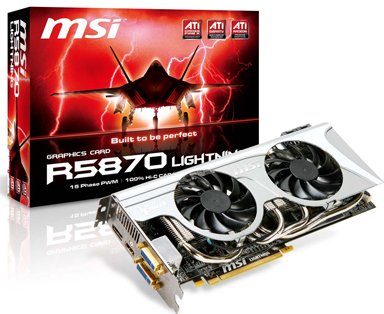
Posted on Thursday, February 25 2010 @ 11:22 CET by Thomas De Maesschalck
MSI introduced the Radeon HD 5870 Lightning Edition, this card is designed for overclockers and features 15-phase power, a special LPL (Lightning Power Layer) PCB design, Hi-c caps, the Twin Frozr II cooler, and many other special features.
World-renowned graphics card and mainboard brand-manufacturer MSI has officially launched a new generation of the Lightning series, the R5870 Lightning. Not only are top-quality components used in the design, but the following features are also included: exclusive all Hi-c CAP for GPU power, 15-phase power design, two 8-pin external power connectors, special PCB design called LPL (Lightning Power Layer), Twin Frozr II Thermal design with 8mm SuperPipe technology…etc. These outstanding features boost overall performance and reliability to a whole new level. This can be described as a top-performing product specifically designed for the extreme gamers and built to be perfect.
15-phase power supply designs, two 8-pin external power connectors* and LPL design to enable more stable power supply
The new MSI R5870 Lightning features the industry's first 15-phase (13+2) power supply design; comparing to the reference-design 7 (5+2)-phase power supply module, it provides more than twice the power required by the GPU; It also features two 8-pin external power connectors, allowing more ample power supply for the R5870 Lightning; In addition, the design of the new R5870 Lightning has also incorporated a dedicated LPL (Lightning Power Layer) design, which is designed for GPU and memory power. This helps to increase the stability of power supply and also reduce noise.
All Hi-c CAP for GPU Power, All-new standard defined with military-class components
In addition to its innovations in power supply design, the all-new MSI R5870 Lightning continues its previous generations' practice of employing military-class components. Moreover, in order to enhance the quality of power supply of GPU, a next-generation capacitor - the Hi-c CAP has been all adopted. Compared with the solid-state capacitors currently used in high-end graphics cards, this new design has 8 times of lifespan, as well as being low-temperature and having better transmission efficiency and other technical characteristics. With the new Hi-c CAP, the life of the graphics card can be substantially extended, operating temperature significantly reduced, thus rewriting the standards for military-class components. To provide better power quality, MSI R5870 Lightning has also introduced the Proadlizer capacitors, which is not only able to accommodate very high current, but can also provide a more stable power supply. Combined with its low ESR, unnecessary heat is reduced to provide a lower operating temperature.
Exclusive Twin Frozr II Thermal Design and SuperPipe Technology
In addition the Twin Frozr II Thermal Design, which follows in the footsteps of the previous Lightning series, is equipped with dual 8cm PWM fans and the best-in-class 8mm SuperPipe technology for cooling efficiency. Heat can be distributed more quickly to the heat-sink, and removed by the dual fans. A single operation takes care of the GPU, memory and PWM modules, and is both efficient and silent; it is currently one of the most advanced thermal designs in the industry.
Exclusive Over Voltage Function of GPU & V-Check Points Support
Apart from the enhanced power supply structure, when the R5870 Lightning graphics card is configured with MSI's exclusive Afterburner overclocking software, not only can common GPU and memory clock adjustment functions be provided, but Over Voltage Function of GPU can be supported as well. This has completely freed up the potential of the graphics card; Meanwhile, MSI R5870 Lightning graphics card also provides the function of V-Check Points. When a multi-meter is attached, the current voltage status of the GPU and memory can be easily obtained without modding any circuit hardware. This provides a very convenient monitoring design.

